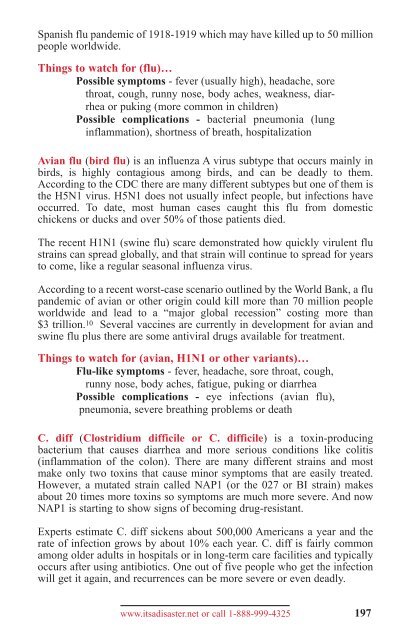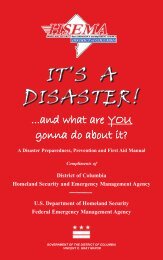disaster 5th 1108_5th ed 2011 - Homeland Security and Emergency ...
disaster 5th 1108_5th ed 2011 - Homeland Security and Emergency ...
disaster 5th 1108_5th ed 2011 - Homeland Security and Emergency ...
You also want an ePaper? Increase the reach of your titles
YUMPU automatically turns print PDFs into web optimized ePapers that Google loves.
Spanish flu p<strong>and</strong>emic of 1918-1919 which may have kill<strong>ed</strong> up to 50 million<br />
people worldwide.<br />
Things to watch for (flu)…<br />
Possible symptoms - fever (usually high), headache, sore<br />
throat, cough, runny nose, body aches, weakness, diarrhea<br />
or puking (more common in children)<br />
Possible complications - bacterial pneumonia (lung<br />
inflammation), shortness of breath, hospitalization<br />
Avian flu (bird flu) is an influenza A virus subtype that occurs mainly in<br />
birds, is highly contagious among birds, <strong>and</strong> can be deadly to them.<br />
According to the CDC there are many different subtypes but one of them is<br />
the H5N1 virus. H5N1 does not usually infect people, but infections have<br />
occurr<strong>ed</strong>. To date, most human cases caught this flu from domestic<br />
chickens or ducks <strong>and</strong> over 50% of those patients di<strong>ed</strong>.<br />
The recent H1N1 (swine flu) scare demonstrat<strong>ed</strong> how quickly virulent flu<br />
strains can spread globally, <strong>and</strong> that strain will continue to spread for years<br />
to come, like a regular seasonal influenza virus.<br />
According to a recent worst-case scenario outlin<strong>ed</strong> by the World Bank, a flu<br />
p<strong>and</strong>emic of avian or other origin could kill more than 70 million people<br />
worldwide <strong>and</strong> lead to a “major global recession” costing more than<br />
$3 trillion. 10 Several vaccines are currently in development for avian <strong>and</strong><br />
swine flu plus there are some antiviral drugs available for treatment.<br />
Things to watch for (avian, H1N1 or other variants)…<br />
Flu-like symptoms - fever, headache, sore throat, cough,<br />
runny nose, body aches, fatigue, puking or diarrhea<br />
Possible complications - eye infections (avian flu),<br />
pneumonia, severe breathing problems or death<br />
C. diff (Clostridium difficile or C. difficile) is a toxin-producing<br />
bacterium that causes diarrhea <strong>and</strong> more serious conditions like colitis<br />
(inflammation of the colon). There are many different strains <strong>and</strong> most<br />
make only two toxins that cause minor symptoms that are easily treat<strong>ed</strong>.<br />
However, a mutat<strong>ed</strong> strain call<strong>ed</strong> NAP1 (or the 027 or BI strain) makes<br />
about 20 times more toxins so symptoms are much more severe. And now<br />
NAP1 is starting to show signs of becoming drug-resistant.<br />
Experts estimate C. diff sickens about 500,000 Americans a year <strong>and</strong> the<br />
rate of infection grows by about 10% each year. C. diff is fairly common<br />
among older adults in hospitals or in long-term care facilities <strong>and</strong> typically<br />
occurs after using antibiotics. One out of five people who get the infection<br />
will get it again, <strong>and</strong> recurrences can be more severe or even deadly.<br />
www.itsa<strong>disaster</strong>.net or call 1-888-999-4325<br />
197





